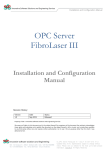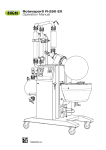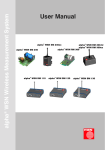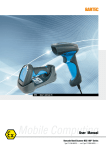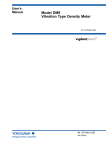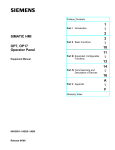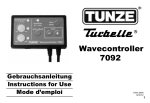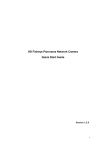Download H Y D R A U L I K Operating instructions submersible pumps, normal
Transcript
HYDRAULIK Operating instructions submersible pumps, normal-priming EWP Edition July 2003 Jahns-Regulatoren GmbH D 63069 Offenbach Sprendlinger Landstraße 150 Telephon ++49 +69 83 10 86 D 63009 Offenbach Postbox 10 09 52 Telefax ++49 +69 83 70 59 www.jahns-hydraulik.de [email protected] Table of contents 1.0 General .................................................................................................. 3 1.1 Areas of application ........................................................................ 3 1.2 Performance Data .......................................................................... 3 2.0 Safety .................................................................................................... 4 2.1 Marking instructions in the operating instructions ........................... 4 2.2 Personnel qualification and training ................................................ 4 2.3 Dangers on non-compliance with the safety instructions ................ 4 2.4 Safety-conscious working ............................................................... 4 2.5 Safety instructions for the operator / user ....................................... 5 2.6 Safety instructions for maintenance work ....................................... 5 2.7 Unauthorized conversion and spare parts manufacture .................. 5 2.8 Inadmissible modes of operation .................................................... 5 3.0 Transport / temporary storage ............................................................ 5 3.1 Transport ........................................................................................ 5 3.2 Temporary storage ......................................................................... 5 4.0 General Description ............................................................................. 6 4.1 Model variations ............................................................................. 6 4.2 Temperatures ................................................................................. 6 5.0 Location, Installation ............................................................................ 7 5.1 Location .......................................................................................... 7 5.2 Installation ...................................................................................... 7 5.3 Hose or pipes ................................................................................. 7 5.4 Filter ............................................................................................... 7 5.5 Pressure line .................................................................................. 7 5.6 Motor connection ............................................................................ 7 6.0 Commissioning..................................................................................... 8 7.0 De-commissioning ............................................................................... 8 8.0 Faults ..................................................................................................... 9 9.0 Maintenance .......................................................................................... 9 9.1 Cleaning ......................................................................................... 9 © Jahns Regulatoren GmbH 2002 Reprinting, even of excerpts, only with our approval. All information has been carefully compiled and checked. Nevertheless we can accept no liability for incomplete or faulty information. Earlier editions of these operating instructions are no longer in force. We reserve the right to make changes. Page 2 1.0 General information Please read all instructions carefully before operating the product, which may not be used by anyone who has not read these instructions or is under 16 years of age. These instructions describe the installation, operation and maintenance of the product and the associated risks. They reflect the state-of-the-art at the time the product was sold and cannot be regarded as inadequate on the basis of subsequent experience or developments. We reserve the right to up-date the product and instructions without undertaking to do the same with products already supplied. The descriptions and instructions contained herein concern the standard model and take account neither of every design detail nor of variations. The following points exclude claims for damage and any consequences resulting therefrom: - incorrect use of the submersible pump - usage that infringes the regulations of the country concerned - incorrect installation - impermissible modifications or interference - incorrect power supply - failure to adhere to the instructions - use of non-original replacement parts. The use of submersible pumps with standard electric motors is prohibited in rooms where there is a danger of explosion or fire. In the case of such applications, do not install the pump and contact us immediately. 1.1 Areas of application The pump may be operated only for the areas of application confirmed by the manufacturer. In the case of changed operating conditions, consult the supplier /manufacturer. 1.2 Performance data The name plate on the pump shows the operating data, the series, the size and the Com. No. When ordering spare parts or in the case of queries, always state this Com. No. In the case of queries please contact your supplier or the manufacturer. Page 3 2.0 Safety These operating instructions contain basic instructions that have to be observed in installation, operation and maintenance. Therefore these operating instructions must be read absolutely before installation and commissioning by the fitter as well as the responsible skilled personnel / operator and must be constantly available at the place of use of the plant. Not only the general safety instructions listed under this main section have to be complied with but also the special safety instructions inserted under the other items. 2.1 Marking instructions in the operating instructions The safety instructions contained in these operating instructions, non-compliance with which can cause danger to persons, are marked specially with the general danger symbol. Achtung! In the case of safety instructions non-compliance with which can cause danger to the agitator and its function, the word ATTENTION! is inserted. Instructions applied directly to the agitator, such as the direction of rotation arrow, must be complied with absolutely and kept in completely legible condition. 2.2 Personnel qualification and training The personnel for operation, maintenance, inspection and installation must have the corresponding qualification for this work. The area of responsibility, competence and supervision of the personnel must be regulated exactly by the operator. If the personnel do not have the necessary knowledge, then they must be trained and instructed. Furthermore the operator must ensure that the contents of the operating instructions are understood fully by the personnel. 2.3 Dangers on non-compliance with the safety instructions Non-compliance with the safety instructions can result in both danger for persons and for the environment and the pump. Non-compliance with the safety instructions leads to loss of any claims for compensation. In detail, non-compliance can for example result in the following dangers: · Failure of important functions of the plant. · Failure of prescribed methods for maintenance and repair. · Endangering persons by electrical, mechanical and chemical effects. · Danger to the environment due to leakage of hazardous substances. 2.4 Safety-conscious working The safety instructions listed in these operating instructions, the existing national regulations for accident prevention as well as possible internal working, operating and safety regulations of the operator must be complied with. Page 4 2.5 Safety instructions for the operator / user If hot or cold pump parts lead to dangers, these parts must be protected against contact. Dangerous goods, e.g. explosive, toxic or hot must be discharged so that no danger for persons and the environment arises. Legal regulations must be observed. Dangers due to electrical energy must be excluded. For details of this refer for example to the regulations of the VDE and of the local energy supply utilities. 2.6 Safety instructions for maintenance, inspection and installation work The operator must ensure that all maintenance, inspection and installation work is performed by authorized and qualified skilled personnel that has informed itself sufficiently by thorough study of the operating instructions. Basically work on the pump may be performed only at standstill. Observe the procedure described in the operating instructions for shutting down the pump. Pump parts which move media endangering health, must be decontaminated. Directly after completion of the work, all safety and protective devices must be refitted or put into operation. 2.7 Unauthorized conversion and spare parts manufacture Achtung! Conversion or modifications of the agitator are permitted only after consultation with the manufacturer. Original spare parts and accessories authorized by the manufacturer serve for safety. The use of other parts excludes liability for the resulting consequences. 2.8 Inadmissible modes of operation The operating safety of the delivered pump is guaranteed only in use as intended. The stated limit values may not be exceeded under any circumstances. 3.0 Transport / temporary storage 3.1 Transport The pump must be transported correctly. Make sure that hoists and slinging gear are sufficiently dimensioned. 3.2 Temporary storage Temporary storage should be dry and free of dust and frost. Protect the pump against penetration of impurities. Following a longer period of storage, it might be necessary to exchange the shaft seals on models B and BF. Page 5 4.0 General description Type EWP submersible pumps are normal suction, single-stage centrifugal pumps made of highly-resistant materials. The body of the pump, standpipe, pressure pipe and support flange are made of PPH, PVDF or PVC. The material chosen depends on what is to be pumped. Models B and BF can also be supplied in V4A. Submersible pumps are intended for use with pure, water-like liquids with no abrasive or fibrous particles. The suction connection is in the middle of the pump body and the pressure connection runs upwards in an axial direction through the support flange. Open, semi-open and channel impellers are used as impellers. 4.1 Model variations B Electric motor (Type B5) of the submersible pump direct on the support flange, shaft made of V4A, plain bearings made of PTFE/carbon, radial sealing ring in the standpipe. BF Electric motor (Type B14) of the submersible pump on the intermediate flange, dynamic seal in the standpipe. BFU Electric motor (Type B14) of the submersible pump on the intermediate flange. No metal parts in the area that comes into contact with the product. The V4A shaft is encased with PPH, PVDF or PVC and, as a rotating part of the plain bearing, has a ceramic sleeve. The stationary parts are made of PTFE/ glass-fibre reinforced plastic or PTFE/carbon. Depending on the liquid, the O-rings are made of FKM (Viton), EPDM or coated PTFE. ZL Intermediate bearing for greater submersion depths. Depending on type, bearing made of PTFE/carbon or ceramic/PTFE/glass-fibre reinforced plastic. FK Filter basket on the intake side. 4.2 Temperatures The maximum permitted temperatures for the pumps are set at PVC 50°C PPH 85°C PVDF 130°C V4A 160°C Page 6 5.0 Location, installation 5.1 Location The location must be chosen so that the pump and motor are easily accessible. The pump must be mounted on a horizontal, flat and solid base. The pump must always be mounted vertically. 5.2 Installation The submersible pump must be bolted to the installation plate so there is no tension or warping. If great importance is attached to vibration-free running, the pump must be installed on a foundation insulated against vibration with no rigid connections between the base plate and the foundation or installation plate. Non-observance of these installation instructions invalidates the guarantee. 5.3 Hoses or pipes Achtung! Hoses or pipes must be protected against frost. Beforehand, clean and make a stress-free connection. Impurities and foreign matter must be prevented from entering the pump by suitable filters on the intake side. The nominal diameter of the pipe must at least correspond with the nominal diameter of the pressure-pipe joint. Steps must be taken to compensate for pipe expansion to avoid extraneous forces on the pump. 5.4 Filter An intake-side strainer is essential if large contaminants are to be expected. 5.5 Pressure line We recommend the installation of a regulatory device behind the pump’s pressurepipe joints to control the output. 5.6 Motor connection The electrical connection of the pump should only carried out by qualified personnel! The connection plan for the motors is fixed to the inside of the lid of the terminal box. In addition to the requirement that the electrical installation be first grade (with adherence to the appropriate guidelines and VDE regulations), special attention should be given to the pump’s direction of rotation, (direction of through-flow), which is indicated on the housing of the pump. A motor protection switch is always necessary for an electric motor (except for the version with the coil protection contact (WSK) or posistor, which are designed to switch the motor off directly). The warranty is not valid, should the motor protection switch not be activated and adjusted for the nominal current (IN). Allow the motor run a briefly to verify that the direction of rotation is according to the direction of rotation arrow. Page 7 6.0 Commissioning The body of the submersible pump must be beneath the liquid level. Submersible pumps do not operate automatically. The maximum liquid level must not be above the top ventilation holes in the standpipe (beneath the connection flange) because, due to the partial vacuum when the vessel is closed, the medium can penetrate the shaft seal, the primary purpose of which is to guard against splashing. Fully open all shut-off valves on the pressure side. Switch on the motor. Set the operating point by closing the pressure-side shut-off valve. If no pressure-side shut-off valve has been installed, the operating point is set automatically in accordance with the equipment characteristics. Do not operate if the sliding valve is closed! Achtung! A minimum level limit must be set if the submersible pump is used for emptying purposes and the liquid level not be permitted to fall lower than the body of the pump. If a suction-pipe extension is used, please note that the submersible pumps do not operate automatically, i.e., if the level falls below the casing, the pump will continue to function until the end of the pipe is reached but, after stopping, it cannot begin again. Dry running for a longer period causes the bearings to overheat. In turn, this reduces the bearing clearance, which can result in the shaft seizing and the destruction of the bearing and its seat. 7.0 De-commissioning Switch off the motor. Close the shut-off valves. If the medium remains in the appliance, the valves should be secured against inadvertent opening. If the return-flow inhibitor is installed in the pressure pipe, the shut-off valve can remain open, as long as a back pressure is present. Achtung! If there is a risk of frost or during long periods of non-operation the pump should be emptied, or protected from freezing! If the pumps are not put into operation until weeks or months after they are delivered, it is necessary to first turn the shaft or ventilator propeller of the motor by hand, in order to gently separate the floating ring seals that may have stuck together. Should the motor start up abruptly, the strong adhesion of the lapped surfaces may cause damage the motor. The shaft must turn against a uniform resistance. If the floating washers do stick together, then a clear recoil momentum is apparent If the equipment is de-commissioned in order to carry out work on the pump, the drive must be secured in such a way that it cannot be switched on, for example lock the switch, if necessary unscrew the fuses, use shorting plugs or disconnect the motor. Page 8 The shut-off unit in the in-flow pipe and pressure pipe must be closed. The pump must have adjusted to the ambient temperature and have been emptied. Pumps that convey mediums presenting a risk to health must be de-contaminated. Immediately after finishing the work, all safety and protection equipment must be re-connected or re-commissioned. 8.0 Faults If operation of the pump is shut down by the motor protection switch, before switching it back on, it is necessary to check whether the pump can be easily turned. In order to do this, turn the shaft of the motor on the ventilation side using a screwdriver or suchlike. Retract the screwdriver. The motor protection or overload switch should only be re-activated after a few minutes. If it cuts out a second time, an expert should be called to determine the cause of the fault. Check the electric supply and fuses! If the pump seizes due to contamination, it must be cleaned. Switching a blocked pump off and on several times can result in damage to the motor. This would invalidate any claim under the warranty. In the case of irregularities we recommend that the pump supplier first be contacted, whilst as an integrated part of equipment, initial contact should be taken up with the supplier of the equipment. 9.0 Maintenance Submersible pumps are maintenance-free in normal operation. The running time depends largely on the mechanical abrasiveness of the liquid. The submersible pump should be inspected visually for external leaks, damage and loose screws, etc., at certain intervals. The ventilation slits on the motor should also be checked and any dust removed so that heat can escape. The bearings should be exchanged if vibrations occur or loud running noises, which indicate a worn out bearing, are to be heard. 9.1 Cleaning All motors are designed to a minimal ingress protection of IP54. Do not direct a jet of water directly at the pump. It is recommended that it be cleaned with a damp sponge or cloth and normal household cleaning agents. Page 9 Förderhöhe (mWS) Gemeinsame Daten der Kreisel- und Tauchpumpen Common data for centrifugal and immersion pumps Caracteristiques communes pompes centrifuges at pompes immergées Fördermenge (m3/h) Bezeichnungen Designations Désignations W, WK, WKT, EWP 100 - 5000 W, WK, WKT, EWP 100 - 5000 W, WK, WKT, EWP 100 - 5000 Pumpenleistungen 3 - 60 m3/h, bei 0,6 - 5 bar. Die Temperaturgrenzen der verschiedenen Ausführungen betragen: Capacities 3 - 60 m3/h, 0,6 - 5 bar. The following temperature limits are applicable for the various models: Capacité 3 - 60 m3/h, 0,6 - 5 bar. Les limites de température des différentes versions sont les suivantes: PP: PP: PP: 85° C 85° C 85° C PVDF: 130° C PVDF: 130° C PVDF: 130° C PVC: PVC: PVC: V4A: V4A: 50° C 160° C (220° C) Motorleistungen: 0,12 - 5,5 kW. Die Motoren sind serienmäßig lieferbar in 230/400 V 50 Hz, 400/690 V 50 Hz, 500 V 50 Hz, 440-480 V 60 Hz. Schutzart IP 55 bis IP 65 Explosionsschutz EExeIIT3 bis EExdeIICT6. 50° C 160° C (220° C) V4A: 50° C 160° C (220° C) Power inputs: 0,12 - 5,5 kW Puissance du moteur: 0,12- 5,5 kW The motors are available as standard for 230/400 V 50 Hz, 400/690 V 50 Hz, 500 V 50 Hz, 440-480 V 60 Hz, Type of enclosure IP 55 to IP 65, Explosionprotection EExeIIT3 to EExdeIICT6. Les moteurs de série sont livrables pour des tensions de 230/400 V 50 Hz, 400/690 V 50 Hz, 500 V 50 Hz, 440-480 V 60 Hz, degré de protection IP 55 à IP 65, Explosionsschutz EExeIIT3 à EExdeIICT6. IHR PARTNER FÜR HYDRAULIKKOMPONENTEN HYDRAULIK Sprendlinger Landstraße 150 JAHNS-REGULATOREN GMBH Telefon 069 / 83 10 86 D 63069 OFFENBACH Telefax 069 / 83 70 59 www.jahns-hydraulik.de










